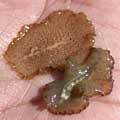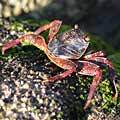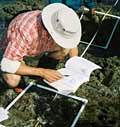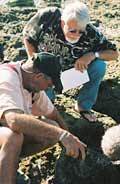With our free press under threat and federal funding for public media gone, your support matters more than ever. Help keep the LAist newsroom strong, become a monthly member or increase your support today .
Echoes of 'The Sea of Cortez'









In 1940, on the eve of World War II, acclaimed author John Steinbeck and his good friend, marine biologist Ed Ricketts, sailed off from the Northern California city of Monterey to explore the Sea of Cortez, the long, narrow gulf between the Baja California peninsula and mainland Mexico.
Steinbeck had just finished The Grapes of Wrath, and Ricketts -- immortalized as Doc in Steinbeck's famous book Cannery Row -- had just finished his seminal study Between Pacific Tides. After their voyage they co-authored Sea of Cortez, a meticulously detailed study of hundreds of tideland species, spiced with philosophical digressions.
A small group of scientists is currently following in the wake of the Ricketts-Steinbeck voyage, hoping to find out how the gulf has changed over the past 64 years. In the latest report for Radio Expeditions, NPR's John McChesney caught up with their boat not long after the crew entered the southern mouth of the Sea of Cortez, near the city of La Paz at the tip of the Baja California peninsula.
The boat used for this modern voyage is the Gus-D, an aging, wooden-hulled shrimp trawler. It's definitely not a luxury cruiser -- her hull is smeared with rust, her rails are splintered, her gear is rusty and sooty. But the scientists insist it's a vessel worthy of the voyage, because it stays loyal to the low-budget spirit of the original trip Steinbeck and Ricketts made in an equally scruffy boat, the Western Flyer.
The sea's warm, protected waters form a massive natural aquarium, one of the most diverse marine environments in the world -- containing everything from 50-ton sperm whales to the tiny animals found in tide pools.
An early stop for Steinbeck and Ricketts was Espiritu Santo Island, described by Steinbeck this way: "mountainous and stands high and sheer from the water." In 1940, Steinbeck and Ricketts detailed tide pools swarming with brittlestars and sea cucumbers, rocks crawling with agile crabs and the nests of countless birds.
Bill Gilly, the new expedition's chief scientist from Stanford University's Hopkins Marine Station, leads a crew of assistants in documenting the current state of tide pools on the island in painstaking detail. He and the other scientists on this journey are hoping their measurements will help future generations gauge the environmental health of a marine life paradise.
"This is really the first site we've come to that has so much diversity that it's really hard to keep up," Gilly says. That's good news. In spite of intensive commercial fishing and shoreline resort development, the sensitive tideland life forms here still seem to be thriving.
Not far away from the place where Gus-D scientists believe Steinbeck and Ricketts made their initial discoveries, huge oil tanks for a refinery hunker on the shore and holiday crowds fill a white beach. The Gus-D crew finds the tide pools still teeming with creatures -- or in the words of Ricketts, "ferocious with life."
Science writer Jon Christensen, the expedition coordinator, says Ricketts' and Steinbeck's book inspired him to undertake this voyage "I think that the log from the Sea of Cortez is a beautiful blending of science and ecology and literature and philosophy," he says. "But I think it was a project that was unfinished."
Ricketts, he says, had a theory that all life on the Pacific seaboard was connected, that what affected one tide pool would influence life in others. It was a radical notion at the time, and Ricketts wanted to test his theory by surveying the coast of the Pacific Northwest.
But the war and personal tragedy intervened. Sea of Cortez was published the same week the Japanese attacked Pearl Harbor. Steinbeck served as a war correspondent, and Ricketts was drafted. A few years after the war, Ricketts was killed at a train crossing.
UPDATE: The crew of the Gus-D returned to port in Monterey, Calif., on May 25th, completing their round-trip Steinbeck-Ricketts odyssey.
Copyright 2022 NPR. To see more, visit https://www.npr.org. 9(MDA1OTI3MjQ5MDEyODUwMTE2MzM1YzNmZA004))
At LAist, we believe in journalism without censorship and the right of a free press to speak truth to those in power. Our hard-hitting watchdog reporting on local government, climate, and the ongoing housing and homelessness crisis is trustworthy, independent and freely accessible to everyone thanks to the support of readers like you.
But the game has changed: Congress voted to eliminate funding for public media across the country. Here at LAist that means a loss of $1.7 million in our budget every year. We want to assure you that despite growing threats to free press and free speech, LAist will remain a voice you know and trust. Speaking frankly, the amount of reader support we receive will help determine how strong of a newsroom we are going forward to cover the important news in our community.
We’re asking you to stand up for independent reporting that will not be silenced. With more individuals like you supporting this public service, we can continue to provide essential coverage for Southern Californians that you can’t find anywhere else. Become a monthly member today to help sustain this mission.
Thank you for your generous support and belief in the value of independent news.

-
The study found recipients spent nearly all the money on basic needs like food and transportation, not drugs or alcohol.
-
Kevin Lee's Tokyo Noir has become one of the top spots for craft-inspired cocktails.
-
A tort claim obtained by LAist via a public records request alleges the Anaheim procurement department lacks basic contracting procedures and oversight.
-
Flauta, taquito, tacos dorados? Whatever they’re called, they’re golden, crispy and delicious.
-
If California redistricts, the conservative beach town that banned LGBTQ Pride flags on city property would get a gay, progressive Democrat in Congress.
-
Most survivors of January's fires face a massive gap in the money they need to rebuild, and funding to help is moving too slowly or nonexistent.







